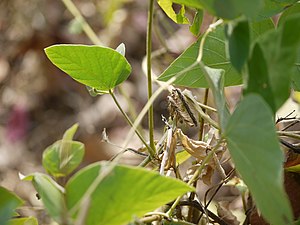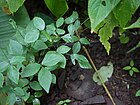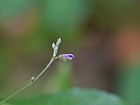Note: This is a project under development. The articles on this wiki are just being initiated and broadly incomplete. You can Help creating new pages.
Difference between revisions of "Teramnus labialis"
(Created page with "{{stub}} ==Uses== {{Uses|}}, {{Uses|}}, {{Uses|}}, {{Uses|}}, {{Uses|}}, {{Uses|}}, {{Uses|}}, {{Uses|}}, {{Uses|}}, {{Uses|}}, {{Uses|}}.<ref name="Uses"/> ==Parts Used== {{...") |
(→Identification) |
||
| (6 intermediate revisions by the same user not shown) | |||
| Line 1: | Line 1: | ||
| − | + | [[File:Teramnus labialis (6425576547).jpg|thumb|right]] | |
| + | '''Teramnus labialis''' is an extremely variable, prostrate or trailing, evergreen herbaceous plant, sometimes becoming woody at the base. The stems can be up to 3 metres long, scrambling over the ground or twining into the surrounding vegetation for support. Some forms are stoloniferous, spreading at the roots, whilst some can shed their leaves in dry periods. | ||
==Uses== | ==Uses== | ||
| − | {{Uses|}}, {{Uses|}}, {{Uses|}}, {{Uses|}}, {{Uses|}}, {{Uses|}}, {{Uses|}}, {{Uses|}}, {{Uses|}}, {{Uses|}}, {{Uses|}}.<ref name="Uses"/> | + | {{Uses|Inflammation}}, {{Uses|Biliousness}}, {{Uses|Blood diseases}}, {{Uses|Gout}}, {{Uses|Fever}}, {{Uses|Bronchitis}}, {{Uses|Thirst}}, {{Uses|Burning sensation}}, {{Uses|Paralysis}}, {{Uses|Rheumatism}}, {{Uses|Haemoptysis}}, {{Uses|Catarrh}}.<ref name="Uses"/> |
==Parts Used== | ==Parts Used== | ||
| − | {{Parts Used|}}, {{Parts Used| | + | {{Parts Used|Seeds}}, {{Parts Used|Fruits}}. |
==Chemical Composition== | ==Chemical Composition== | ||
| − | <ref name="chemical composition"/> | + | It contains Crude protein, crude fat, ash, and nitrogen freeextracts constituted 22.86%, 6.10%, 4.62%, and,58.15%, respectively, of the seed weight. The caloricvalue of 100 g dry matter of seed material was 378.94kcal.<ref name="chemical composition"/> |
==Common names== | ==Common names== | ||
| − | {{Common names|sa=|en=|gu=|hi=|kn=|ks=|ml=|mr=|pa=|ta=|te=}} | + | {{Common names|sa=|en=Blue wiss|gu=|hi=|kn=Kadu uddu|ks=|ml=|mr=|pa=|ta=|te=}} |
==Properties== | ==Properties== | ||
| Line 16: | Line 17: | ||
===Dravya=== | ===Dravya=== | ||
===Rasa=== | ===Rasa=== | ||
| − | |||
===Guna=== | ===Guna=== | ||
| Line 29: | Line 29: | ||
==Habit== | ==Habit== | ||
| − | {{Habit|}} | + | {{Habit|Perennial climber}} |
==Identification== | ==Identification== | ||
===Leaf=== | ===Leaf=== | ||
| − | {{Leaf|||}}<ref name="Leaf"/> | + | {{Leaf|Trifoliate|Rounded leaf stalks|0.9 tp 4cm long}}<ref name="Leaf"/> |
===Flower=== | ===Flower=== | ||
| − | {{Flower||||}} | + | {{Flower|Obovate|5mm X 3.5mm|Petal white|Pink or purplish|Flowering season is throught the year}} |
===Fruit=== | ===Fruit=== | ||
| − | {{Fruit||||||}} | + | {{Fruit||||||Fruiting season is throught the year}} |
===Other features=== | ===Other features=== | ||
| Line 48: | Line 48: | ||
==Mode of Propagation== | ==Mode of Propagation== | ||
| − | {{Propagation|}} | + | {{Propagation|Seeds}} |
| + | |||
| + | ==Season to grow== | ||
| + | Wet season. | ||
| + | |||
| + | ==Soil type required== | ||
| + | Found in well- (rarely poorly-) drained sands to clays with pH (5.5‒) 6.0‒8.0 (‒9.0). Although originating from mostly near neutral to alkaline soils. | ||
| + | |||
| + | ==Ecosystem/Climate== | ||
| + | Mostly collected in run-on or moister areas, in regions with average annual rainfall (500‒) 750‒1,500 (‒2,500) mm.<ref name="Ecosystem/Climate"/> | ||
==How to plant/cultivate== | ==How to plant/cultivate== | ||
| − | <ref name="How to plant/cultivate"/> | + | A plant of the moist tropics, where it is found at elevations from sea level up to 3,000 metres.<ref name="How to plant/cultivate"/> |
==Commonly seen growing in areas== | ==Commonly seen growing in areas== | ||
| − | {{Commonly seen|}}, {{Commonly seen|}}, {{Commonly seen|}}, {{Commonly seen| | + | {{Commonly seen|Grasslands}}, {{Commonly seen|Grasslands with scattered trees}}, {{Commonly seen|Thickets}}, {{Commonly seen|Forest clearings}}. |
==Photo Gallery== | ==Photo Gallery== | ||
<gallery class="left" caption="" widths="140px" heights="140px"> | <gallery class="left" caption="" widths="140px" heights="140px"> | ||
| − | + | Visarini (Sanskrit- विसारिणी) (6155898313).jpg | |
| + | Adavi Uddu (Kannada- ಅಡವಿ ಉದ್ದು) (2934226120).jpg | ||
| + | Horse vine (6155915293).jpg | ||
| + | Teramnus labialis (6425576547).jpg | ||
| + | Teramnus labialis var. mollis (8105935980).jpg | ||
</gallery> | </gallery> | ||
==References== | ==References== | ||
<references> | <references> | ||
| − | + | <ref name="chemical composition">[https://link.springer.com/article/10.1023/A:1008101805505 Chemical constituents]</ref> | |
| − | <ref name="chemical composition">[ | + | <ref name="Leaf">Kappatagudda - A Repertoire of Medicianal Plants of Gadag by Yashpal Kshirasagar and Sonal Vrishni, Page No. 366</ref> |
| − | + | <ref name="How to plant/cultivate">[http://tropical.theferns.info/viewtropical.php?id=Teramnus+labialis Cultivation]</ref> | |
| − | <ref name="Leaf"> | ||
| − | |||
| − | <ref name="How to plant/cultivate">[ | ||
<ref name="Uses">Indian Medicinal Plants by C.P.Khare</ref> | <ref name="Uses">Indian Medicinal Plants by C.P.Khare</ref> | ||
| + | <ref name="Ecosystem/Climate">[https://apps.lucidcentral.org/tropical_forages/text/entities/teramnus_labialis.htm Ecosystem/Climate]</ref> | ||
</references> | </references> | ||
==External Links== | ==External Links== | ||
| − | * [ ] | + | * [https://www.ijpsonline.com/articles/antiinflammatory-constituents-of-teramnus-labialis.html Teramnus labialis on ijpsonline.com] |
| − | + | ||
| − | |||
[[Category:Herbs]] | [[Category:Herbs]] | ||
Latest revision as of 18:22, 20 May 2021
Teramnus labialis is an extremely variable, prostrate or trailing, evergreen herbaceous plant, sometimes becoming woody at the base. The stems can be up to 3 metres long, scrambling over the ground or twining into the surrounding vegetation for support. Some forms are stoloniferous, spreading at the roots, whilst some can shed their leaves in dry periods.
Contents
- 1 Uses
- 2 Parts Used
- 3 Chemical Composition
- 4 Common names
- 5 Properties
- 6 Habit
- 7 Identification
- 8 List of Ayurvedic medicine in which the herb is used
- 9 Where to get the saplings
- 10 Mode of Propagation
- 11 Season to grow
- 12 Soil type required
- 13 Ecosystem/Climate
- 14 How to plant/cultivate
- 15 Commonly seen growing in areas
- 16 Photo Gallery
- 17 References
- 18 External Links
Uses
Inflammation, Biliousness, Blood diseases, Gout, Fever, Bronchitis, Thirst, Burning sensation, Paralysis, Rheumatism, Haemoptysis, Catarrh.[1]
Parts Used
Chemical Composition
It contains Crude protein, crude fat, ash, and nitrogen freeextracts constituted 22.86%, 6.10%, 4.62%, and,58.15%, respectively, of the seed weight. The caloricvalue of 100 g dry matter of seed material was 378.94kcal.[2]
Common names
| Language | Common name |
|---|---|
| Kannada | Kadu uddu |
| Hindi | |
| Malayalam | |
| Tamil | |
| Telugu | |
| Marathi | |
| Gujarathi | |
| Punjabi | |
| Kashmiri | |
| Sanskrit | |
| English | Blue wiss |
Properties
Reference: Dravya - Substance, Rasa - Taste, Guna - Qualities, Veerya - Potency, Vipaka - Post-digesion effect, Karma - Pharmacological activity, Prabhava - Therepeutics.
Dravya
Rasa
Guna
Veerya
Vipaka
Karma
Prabhava
Habit
Identification
Leaf
| Kind | Shape | Feature |
|---|---|---|
| Trifoliate | Rounded leaf stalks | 0.9 tp 4cm long |
Flower
| Type | Size | Color and composition | Stamen | More information |
|---|---|---|---|---|
| Obovate | 5mm X 3.5mm | Petal white | Pink or purplish | Flowering season is throught the year |
Fruit
| Type | Size | Mass | Appearance | Seeds | More information |
|---|---|---|---|---|---|
| Fruiting season is throught the year |
Other features
List of Ayurvedic medicine in which the herb is used
Where to get the saplings
Mode of Propagation
Season to grow
Wet season.
Soil type required
Found in well- (rarely poorly-) drained sands to clays with pH (5.5‒) 6.0‒8.0 (‒9.0). Although originating from mostly near neutral to alkaline soils.
Ecosystem/Climate
Mostly collected in run-on or moister areas, in regions with average annual rainfall (500‒) 750‒1,500 (‒2,500) mm.[4]
How to plant/cultivate
A plant of the moist tropics, where it is found at elevations from sea level up to 3,000 metres.[5]
Commonly seen growing in areas
Grasslands, Grasslands with scattered trees, Thickets, Forest clearings.
Photo Gallery
References
- ↑ Indian Medicinal Plants by C.P.Khare
- ↑ Chemical constituents
- ↑ Kappatagudda - A Repertoire of Medicianal Plants of Gadag by Yashpal Kshirasagar and Sonal Vrishni, Page No. 366
- ↑ Ecosystem/Climate
- ↑ Cultivation
External Links
- Ayurvedic Herbs known to be helpful to treat Inflammation
- Ayurvedic Herbs known to be helpful to treat Biliousness
- Ayurvedic Herbs known to be helpful to treat Blood diseases
- Ayurvedic Herbs known to be helpful to treat Gout
- Ayurvedic Herbs known to be helpful to treat Fever
- Ayurvedic Herbs known to be helpful to treat Bronchitis
- Ayurvedic Herbs known to be helpful to treat Thirst
- Ayurvedic Herbs known to be helpful to treat Burning sensation
- Ayurvedic Herbs known to be helpful to treat Paralysis
- Ayurvedic Herbs known to be helpful to treat Rheumatism
- Ayurvedic Herbs known to be helpful to treat Haemoptysis
- Ayurvedic Herbs known to be helpful to treat Catarrh
- Herbs with Seeds used in medicine
- Herbs with Fruits used in medicine
- Herbs with common name in Kannada
- Herbs with common name in English
- Habit - Perennial climber
- Index of Plants which can be propagated by Seeds
- Herbs that are commonly seen in the region of Grasslands
- Herbs that are commonly seen in the region of Grasslands with scattered trees
- Herbs that are commonly seen in the region of Thickets
- Herbs that are commonly seen in the region of Forest clearings
- Herbs





